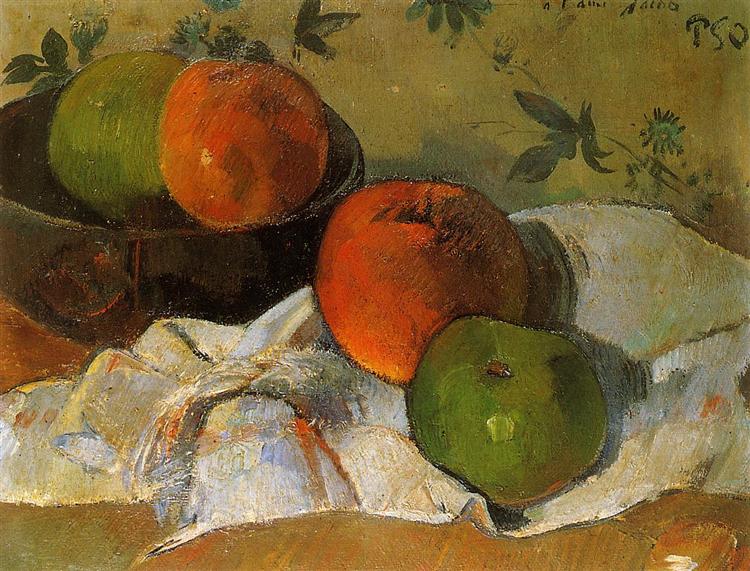Description
Paul Gauguin's "Apples in a Bowl" (1888) is a magnificent representation of the transition between Post-Impressionism and the beginnings of Symbolism, a period in which the artist sought to distance himself from naturalistic representation in favor of a more subjective and often meaningful expression. In this painting, Gauguin chooses an everyday subject, but approaches it with a singularity that transforms the simple object into a field of visual and sensorial exploration.
The composition focuses on a bowl of apples placed on a table, with a warm, soft background that seems to embrace the elements in the foreground. The apples are the undisputed protagonists; their vibrant color—various shades of red and yellow—contrast delicately with the more neutral background, allowing the viewer to focus on their solidity and volume. Gauguin is not concerned with a realistic representation of these fruits, but instead plays with saturation and simplification of forms to evoke sensations rather than everyday realities. This is typical of Gauguin’s style, who, throughout his career, opposed direct visual representation in favor of a more idealized and emotive vision.
The colors in “Apples in a Bowl” are a testament to Gauguin’s use of characteristically bold palette. We notice the presence of shadows in shades of dark blue that add depth, contrasting with the warm yellow and red hues of the apples. The light seems to filter in at an angle that gives the surface of the fruits an almost ethereal luminosity, inviting the viewer into a rich visual experience. This quality of light is one of the hallmarks of Post-Impressionism, where lighting enhances form and certainly establishes an emotional connection with the viewer.
Furthermore, the arrangement of the elements – the bowl is not completely centered, and the edge of the table is presented in a somewhat unusual way – induces a feeling of intimacy and honesty in the work. This lack of perfection is a reflection of Gauguin’s vision, which opposed the conventions of academic art. In this painting, there are no human characters, but the presence of the apples suggests a dialogue between nature and the environment created by the artist, leading to a reflection on the everyday, art and life itself.
Within the context of his overall work, “Apples in a Bowl” aligns with the series of still lifes that Gauguin explored in this period. Similar paintings, such as those by Cézanne, also addressed the same genre, but Gauguin’s interpretation and approach to color and emotion differ markedly. His desire to push the simple into the symbolic or emotional resonates in this work, inviting interpretation beyond the depicted object.
Thus, “Apples in a Bowl” is not only a work about the representation of fruit, but a piece that delves into the psychology of color, form, and symbolism. With this work, Gauguin not only captures the essence of his era, but establishes a bridge to the expressionism and symbolism that influenced later generations of artists. Through its bold style and commitment to personal expression, this painting remains a testament to his artistic genius and his ability to transform the everyday into an encounter with the sublime.
KUADROS ©, a famous painting on your wall.
Hand-made oil painting reproductions, with the quality of professional artists and the distinctive seal of KUADROS ©.
Painting reproduction service with satisfaction guarantee. If you are not completely satisfied with the replica of your painting, we will refund 100% of your money.

